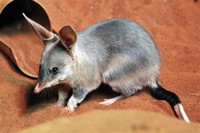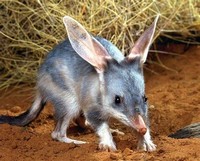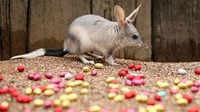Facts about Bilbies

Bandicoots and bilbies are solitary and territorial, but male territories overlap with that of several females.

Bilbies have a very short gestation period of about 12–14 days (Gordon 1984).

The lower jaw morphology suggested a relationship with bilbies (Family Thylacomyidae), and was named Ischnodon australis (Stirton 1955).

Bilbies are slowly becoming endangered because of habitat loss and change as well as the competition with other animals.

The fossorial bilbies are the only peramelemorphs to dig their own burrows (other than some bandicoots constructing makeshift burrows to get out of hot weather).

Bilbies have the characteristic long bandicoot muzzle and very long ears.

Bandicoots and bilbies are omnivorous and consume ants, insect larvae, termites, earthworms, spiders, centipedes, grasses and seeds, and bulbs, and some eat bird eggs, lizards, and mice.

Bandicoots and bilbies play a vital role in the ecosystem, both in terms of food chains and control of insect pest populations.

Today, however, it is common to group the extant bandicoots, bilbys, and pig-footed bandicoot in their own families; respectively, Peramelidae (bandicoots and echymiperas), Thylacomyidae (bilbies), and Chaeropodidada (pig-footed bilby).

Early classification of Peramelemorphia divided the group into two families, with one family simply grouping the short-legged and mostly herbivorous bandicoots, and the other the longer-legged, nearly carnivorous bilbies.

Bandicoots and bilbies occupy a large variety of habitats, ranging from deserts to grasslands to rainforests.
